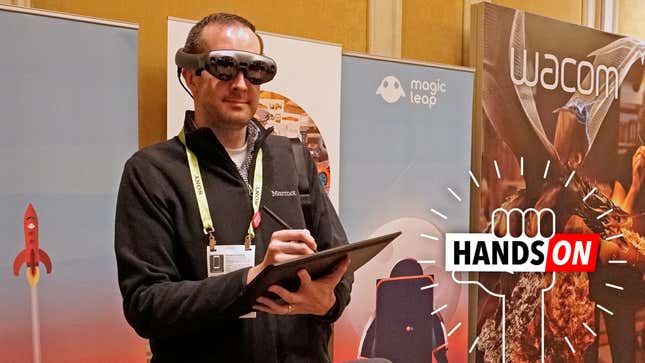
Fields as diverse as video game development, visual effects, and industrial design all rely on 3D software, but the tools used to make it remain firmly stuck in two-dimensions. For the past few years, Magic Leap’s mixed reality goggles have been heralded as the missing link between the digital 3D world and the real one we live in, but it’s Wacom who’s working on turning the hardware into a next-generation creative tool, and not just another expensive way to play games.
Developing 3D content using two-dimensional tools is far from an impossible challenge. We’ve had 3D animations dating back to as far as 1972 when Pixar’s Ed Catmull created a crude 3D wireframe hand using what’s now considered ancient computer technology. Artists and designers have just had to learn to make do with the limitations of the available tools when using computers to create 3D content—or find less-than-ideal compromises to their workflow.
For example, the majority of the design process for a new car is done with complex 3D modeling software that allows the vehicle to be visualized and manipulated from any angle, but that all happens on a two-dimensional computer screen. Before a new car actually goes into production, carmakers will still produce physical prototypes to visualize its design in the real-life, 3D world we’re all familiar with. Visual effects studios working to bring 3D characters to the big screen will often do the same thing; creating physical statues and maquettes of a fictional CG character that make it easier for human eyes to study and critique its design than with the digital version that only resides on a flat screen. Even with modern innovations like 3D printing, producing those real-world prototypes isn’t fast, and it definitely isn’t cheap.
This is where Wacom feels the Magic Leap hardware, which many have eyed skeptically after burning through billions of dollars during its many years of development, could be a genuinely useful productivity tool in the design field. For the past few years, the two companies have been working together to allow Wacom’s industry-standard drawing tablets to be used to create and navigate 3D content in Magic Leap’s simulated, but surprisingly convincing, 3D environment.
At CES this year, Wacom gave me the chance to strap on a Magic Leap headset and try out Spacebridge, which is the behind-the-scenes software Magic Leap has developed that allows a 2D tablet to manipulate 3D objects and workspaces.
There was definitely a learning curve involved, partly because it was the first time I’ve tried the Magic Leap hardware, but also because Wacom’s software has only just entered the beta phase of its development. But having relied on a Wacom tablet every day since as far back as 2002, it didn’t feel like I was having to learn to ride a bike all over again. There’s certainly no shortage of wands, joysticks, and controllers that can be used with VR and MR headsets, but Wacom has done a solid job at making a stylus-driven two-dimensional tablet—which countless designers and artists are already intimately familiar with—feel like a comfortable way to work and be productive in 3D.
The simple demo I tried involved a 3D model of a shoe which appeared to hang in the air right in front of my eyes through the Magic Leap headset. Using a Wacom tablet and stylus, I could reposition, enlarge, and spin the shoe; and even doodle all over it. It’s an obvious and simple demonstration of the technology Wacom has co-developed with Magic Leap, but one that also hints at how mixed-reality could be a vital tool for 3D content creators.
Virtual reality systems like the Oculus Rift can definitely give a user a sense of scale, requiring someone to physically look up to take in the towering might of a virtual dinosaur, for example. But mixed reality, which allows a user to see 3D creations in the real world all around them, makes it easier for the human brain to accurately gauge its size and scale. That’s especially important for industries like industrial design, where a 3D object will eventually be turned into a real product that people physically interact with. A designer would not only be able to visualize it in three-dimensions through the Magic Leap hardware, but they could also walk around it, and even compare it to other real-life products, or previous iterations of the same thing. An Apple designer could hold the iPhone XS in one hand, and a virtual version of the next iPhone in the other.
Wacom also sees the Magic Leap headset as being a fantastic tool for creative collaboration and feedback, as multiple people can explore, study, and even modify a 3D object all at the same time. But they don’t necessarily all have to be in the same room or even the same city. Imagine an actor being able to virtually try on a costume before the props department at a studio in another country turns a digital concept design into a real-world outfit.
There’s been a lot of discussion about how the Magic Leap hardware could eventually be used, but no must-have applications to justify the massive hype behind the product just yet. Education and gaming are obvious uses, but the headsets are expensive and will be for quite some time. That makes it hard to justify Magic Leap as a toy, but put it in the hands of a 3D designer and suddenly $2,000+ is a bargain when the headset radically changes and streamlines an expensive workflow.
Correction, January 14, 2018, 2:50 p.m. EST/EDT: We previously referred to the Spacebridge software as being developed by Wacom, when it was actually developed by Magic Leap.